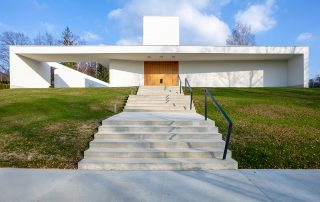We intended to follow quite a simplistic design, emphasizing the spirit of the place and the superior panoramic view rather than the shape of the house. We were to ensue the “less is more”, “simple and great” principle. After all, this schematic building form, this house-archetype fitted into the idea that refreshes and makes the traditional modern.
That is why the form-shaping of the building seems not very complicated (and it was not a goal) and everyone recognizes the archetype of the traditional gabled building.
Thus, we deprived the form of all frippery and allowed the walls, the pitched roof and the glass surface opening towards the street, dominating the outer view. The architectural details are, however, the pledge of freshness and re-interpretation. Elaboration of each node required significant technical knowledge, a lot of coordination and strategic technical planning, so that we could create a new quality with no compromises.
The building opened with south glass walls towards the street is orientated to the city, so that the living room and the bedroom have a perfect view of Gellérthegy (an iconic hill on the Buda side of Budapest), the Parliament, the meandering Danube and the whole bustling downtown of Pest.
In terms of engineering, V-House is a low-energy, A + energy rated building designed to use renewable energy sources. The energy aspects of the wall and roof meet the near-zero energy classification standards. Solar panels are placed to certain individual parts of the building, this is how the energy-requirements of the domestic equipment are met. For the heating/cooling and hot water there is an air-to-water heat-pump system that operates on GEO-tariff. The building components are individually prepared for solar panels. The electric meter spins back and forth, that is, the excess energy generated by solar panels is fed back to the ELMŰ (Budapest Electricity Company) system, and when the house needs extra energy it is purchased from the ELMŰ system. The apartments have a smart home control installed. With the temperature, humidity and wind sensors the building can control itself, it operates the shielding, the heating and cooling systems and other consumer electronics.





Credits
Architecture
Reload Architects’ Studio
Chief architects: Péter Csizmadi DLA; Anikò Petőcz-Tòth
Client
private client
Year of completion
2014 – 2015
Location
Üröm, Hungary
Area
278 sqm (gross built area)
Photos
Krisztián Bódis
Project Partners
OK Atelier s.r.o., MALANG s.r.o.









